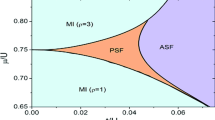Abstract.
We address the problem of two pairs of fermions living on an arbitrary number of single-particle levels of a potential well (mean field) and interacting through a pairing force in the framework of the Richardson equations. The associated solutions are classified in terms of a number vl, which reduces to the seniority v in the limit of a large pairing strength G and yields the number of pairs not developing a collective behaviour, their energy remaining finite in the G↦∞ limit. We express analytically, through the moments of the single-particle levels distribution, the collective mode energy and the two critical values Gcr+ and Gcr- of the coupling which can exist on a single-particle level with no pair degeneracy. Notably Gcr+ and Gcr-, when the number of single particle levels goes to infinity, merge into the critical coupling of a one-pair system Gcr (when it exists), which is not envisioned by the Richardson theory. In correspondence of Gcr, the system undergoes a transition from a mean-field- to a pairing-dominated regime. We finally explore the behaviour of the excitation energies, wave functions and pair transfer amplitudes versus G finding out that the former, for G > Gcr-, come close to the BCS predictions, whereas the latter display a divergence at Gcr, signaling the onset of a long-range off-diagonal order in the system.
Similar content being viewed by others
References
M.B. Barbaro, R. Cenni, A. Molinari, M.R. Quaglia, Phys. Rev. C 66, 034310 (2002).
G. Sierra, J. Dukelsky, G.G. Dussel, J. von Delft, F. Braun, Phys. Rev. B 61, 11890 (2000).
J. Dukelsky, C. Esebbag, P. Schuck, Phys. Rev. Lett. 87, 066403 (2001).
M. Gaudin, Modeles exactement resolus (Les Editions de Physique, 1995).
J.M. Roman, G. Sierra, J. Dukelsky, Phys. Rev. B 67, 064510 (2003).
R.W. Richardson, J. Math. Phys. 6, 1034 (1965).
R.W. Richardson, N. Sherman, Nucl. Phys. 52, 221 (1964).
E.A. Yuzbashyan, A.A. Baytin, B.L. Altshuler, Phys. Rev. B 68, 214509 (2003).
M. Hasegawa, S. Takaki, Phys. Rev. C 35, 1508 (1987).
J.M. Roman, G. Sierra, J. Dukelsky, Nucl. Phys. B 64, 483 (2002).
M. Schechter, Y. Imry, Y. Levinson, J. von Delft, Phys. Rev. B 63, 214518 (2001).
M.B. Barbaro, A. Molinari, F. Palumbo, M.R. Quaglia, Phys. Lett. B 476, 477 (2000).
D. Bés, R.A. Broglia, Nuclear superfluidity and field theory of elementary excitations, in Proceedings of the International School of Physics ‘‘Enrico Fermi’’, Course LXIX, edited by A. Bohr, R.A. Broglia (North-Holland, 1977) p. 59.
P.W. Anderson, J. Phys. Chem. Solids 11, 28 (1959).
Author information
Authors and Affiliations
Corresponding author
Additional information
G. Orlandini
Rights and permissions
About this article
Cite this article
Barbaro, M.B., Cenni, R., Molinari, A. et al. The many levels pairing Hamiltonian for two pairs. Eur. Phys. J. A 22, 377–390 (2004). https://doi.org/10.1140/epja/i2004-10043-7
Received:
Accepted:
Published:
Issue Date:
DOI: https://doi.org/10.1140/epja/i2004-10043-7




